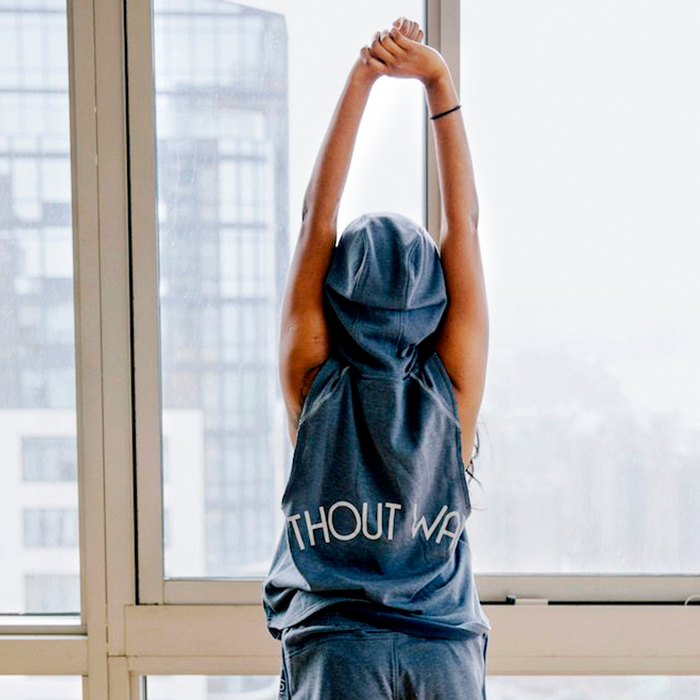If You Hate Yoga as a Workout, Try the Mental Version Instead


While I maintain that there is a form of yoga for everyone—truly, the varieties are endless, and the beauty of the ancient practice is that you make it your own—I also respect that some people just can't get behind it as a workout. Just as I will always see long-distance running as a special kind of torture, others don't particularly enjoy contorting themselves into sustained, balance-driven postures.
But in my years of relatively consistent yoga practice, I've also learned that better posture, increased flexibility, and sinewy arms are nice, the physicality is not entirely the point. To the contrary, in the years I spent warring with my body, yoga was one of the only things that allowed me to truly escape it.
For a few hours each week, I knew I was more than the toxic thoughts that ruled my existence and more than what I thought I saw in the mirror. These were the crucial moments when I started holding myself with empathy and without judgment, and in that way, yoga saved me. Soon, that mindset began to linger after I rolled up my mat and walked out of the studio—until one day I realized it had become my reality.
"Contrary to what we see now, traditional yoga texts barely mentioned the physical poses," says Claire Fountain, yogi, fitness expert, and founder of Trill Yoga. "It is easy to get caught up in the idea that yoga is a combination of contortion-level poses for flexible people, especially in our age of social media. But the true gifts of yoga come from the mental, psychological, and spiritual aspects, and not so much to do with the physical. If anything, yoga can help you transcend the physical body in this way."
"Yoga is a lifestyle," adds Danielle Cuccio, yogi and founder of Cuccio Somatology. "It's not just about doing Warrior II or going through a Vinyasa—it's about wanting to continue the breathing, the healthy mindset, the balance, and treating your mind and body well after that hourlong practice."
That said, there's a certain ambiguity around treating yoga as more of a mental pursuit—relative, at least, to concrete postures. So what does practicing mental yoga really look like?
Let's start with the traditional POV.
If we're diving deep into yogic philosophy, we'd be remiss not to mention the eight limbs of Ashtanga yoga. These principles comprise The Yoga-Sutra of Patanjali, one of the oldest and authoritative texts in the school of yoga, and essentially serve as guidelines for living your most enlightened life.
While The Yoga-Sutra makes for a compelling and nourishing read, you don't have to study every single component of the eight limbs to benefit from their wisdom. "The first two limbs consist of things like being ethical, moral, honest, kind, spiritual, and self-disciplined, and then move into the asanas and meditation with the following limbs," says Fountain.
At the very least, it's worth versing yourself on the first limb (called yama), which focuses on our character and how we conduct ourselves in life. This limb asks that we eschew violence, that we be honest, that we don't steal or covet, and that we practice restraint. Basically, it's about scrutinizing your own code of ethics and morality—and how that colors the relationship you have with yourself as much as with others.
Know that to do good in the world, you have to be good to yourself.
This notion has probably been my biggest hurdle on the road to self-realization. A natural people-pleaser, it took years for me to even consider putting my owns needs first—I always assumed this made me selfish or unlikable. But it's a fundamental truth of self-care—and authentic self-care, not the "treat yo'self!" variety that it's morphed into in the age of social media—that we can bring so much more to the world when we are secure, confident, and self-aware. That begins by looking inward and acknowledging what you need at any given moment—even if what you really need is a break. There's so much truth to the old saying that we sometimes can't see the forest for the trees—how can we have a realistic perspective and engage with the world in a productive manner if we're wrapped up in our insecurities?
Cuccio says that it's just as powerful to know when you can't put the work in as it is to know that you can. "I try to tell myself kindly, 'Not today,'" she says. "Or if I feel like I can give a bit more energy another day, I absolutely do. It's about being honest with yourself, your energy levels, and how you're feeling. It's knowing when I can give more to others or when I need to give more time to myself."
The tricky part is figuring out a way to practice this kind of self-awareness that works for you—whether it's the physical practice of yoga or an alternative that's off the mat (more on that in a minute). But when you figure out your strategy, it's amazing to see how your attitude begins to shift in real time. (Spoiler alert: You'll have countless moments in which you recognize your own growth and inherent wisdom.)
"It's like creating ripples," says Fountain. "We have to make sure we are good on us before we can be good for anyone else, our communities, or the world at large."
Don't be surprised if you no longer need external validation.
We live in a tough, judgmental culture—and with the rise of social media, it's no wonder that we might confuse our authentic selves with the image we (quite literally) present to the world. There's more pressure than ever to conform to societal ideals. (Thanks, Instagram.) But by asking that we quietly acknowledge our thoughts and feelings without judgment, yoga makes it easier to start to peel back the layers of ego and better understand who we are and our inherent value and to know that our individuality is our magic.
"The more we can be grounded in ourselves and confident in our intrinsic gifts, the more we can be realistic about social posturing and see through the facades that are created on social media or any media really," says Fountain. "[And then] we are settled in our own self-confidence and inner peace, so we can let go of the need for outward validation or the need to compare (as a means to feel better about ourselves."
It's not about being quiet or calm.
Fountain points out a common (and borderline dangerous) misconception: That to be "yogic," we have to fit this beatific image of preternatural zen. Careful—that's just your ego talking and can only prevent you from finding the most authentic version of yourself.
"It's a mindset that does not allow for us to be human or for us to be activists as we see fit for the good of all people," says Fountain. "Yes, yoga provides a sense of calm and peace, but it does not mean we are submissive or void of human feelings and emotions like anger, pain, and frustration." The difference, she says, is how we learn to approach those feelings: "It might change from a place of reacting in rash ways before to responding in responsible ways after."
"This all sounds great—but how do I get started?"
It's ultimately up to you to figure out how to get to a meditative place—something that might take a bit of trial and error and will certainly take practice. The reason the physical practice of yoga is such a tried-and-true method after all these centuries is that it requires an acute sense of focus that tends to hush all other mental chatter—and when that happens, you realize you never needed the chatter in the first place. But it's also not for everybody, and there are other strategies to help facilitate that mindset. Consider the following…
- Guided meditation. Don't feel pressured to sit still for 20 minutes, especially on your first go-around—start with five (or even two!) minutes and see what comes up. Headspace is a great app for this because it was made for busy, distracted people—a few minutes is all you need to find a little peace and clarity. (And in time, you may find yourself craving more.)
- Active meditation. This is my preferred method, as I find that hiking and walking in solitude puts me in the same mental space as a sweaty yoga class. Music does the trick too.
- Focus on your breath. This is a crucial part of the physical yoga practice that you can take virtually anywhere. It's not just about acknowledging your breath, but it's also about appreciating it at any given moment. "I value my breath, and return to it whenever I need to," says Fountain. The next time you feel your mind going into overdrive or your emotions taking over, sit quietly and breathe in and out on a count of four.
- Journaling. Both Fountain and Cuccio swear by it, and scientists do too. "It's a means of introspection and growth," says Fountain. Sometimes all we need to gain perspective on our emotions is to see them right in front of us, which makes writing it down a rewarding exercise in self-awareness.
- Give a beginner's or nonphysical yoga class a try. Vinyasa yoga might dominate the fitness scene, but there are also many classes that focus more on meditation and deep stretching. Or you might give it a go at home. "Learn a simple sun salutation or find an online beginner's class that focuses less on physical extremes or fitness aspects," suggests Fountain. "Not every class will be a perfect fit if you're going for a more mental-based practice, but once you have a more internal gaze going for you, you will be able to incorporate these aspects into any class you attend."
And if you don't like a class? "Finish with your final relaxation, give a silent blessing, and choose another or start a home practice," says Fountain—or any of the other suggestions listed here. "Remember: It's a journey, not a destination."
Disclaimer
This article is provided for informational purposes only and is not intended to be used in the place of advice of your physician or other medical professionals. You should always consult with your doctor or healthcare provider first with any health-related questions.

